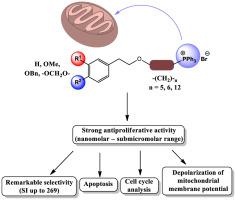European Journal of Medicinal Chemistry ( IF 6.0 ) Pub Date : 2021-11-17 , DOI: 10.1016/j.ejmech.2021.113980 Francisco J Hicke 1 , Adrián Puerta 2 , Jelena Dinić 3 , Milica Pešić 3 , José M Padrón 2 , Óscar López 1 , José G Fernández-Bolaños 1

|
The necessity for developing novel cytostatic agents with improved activities and reduced side-effects to tackle cancer prompted us to investigate mitochondria-targeted compounds, an approach that is gaining attention for the selective transportation of cytotoxic agents.
We envisioned the possibility of conjugating a phenethyl alcohol motif, decorated with a series of phenol-based substituents on the aryl moiety, with a triphenyl phosphonium scaffold (a mitochondria-directed vector), through a hydrocarbon chain of different lengths. Thus, such compounds that incorporate the phenethyl skeleton can be considered as masked phenolic compounds derived from relevant natural counterparts found in olive tree (e.g. tyrosol, hydroxytyrosol).
Title compounds exhibited very strong in vitro antiproliferative activities against the panel of six human tumor cell lines tested, with GI50 values ranging from the nanomolar (0.026 ± 0.010 μM for 36) to the submicromolar range in most of the cases; this represents an improvement of up to 350-fold compared to classical chemotherapeutic agents, like 5-fluorouracil or cisplatin. Interestingly, decrease in the linker length led to an increase of GI50 values against non-tumor cells, thus allowing a remarkable improvement of selectivity (SI up to 269).
The very promising antiproliferative activities prompted us to further investigate their behaviour against multidrug resistant cell lines (MDR). The results indicated a reduced sensitivity of the multidrug resistant cells to compounds, probably due to P-gp-mediated efflux of these antiproliferative agents. Interestingly, activities were completely restored to the same levels by co-administration of tariquidar, a well-known inhibitor of P-gp.
Flow cytometry analysis on sensitive cell lines revealed a decrease in the percentage of cells in G1 phase accompanied by increase in S and G2/M phases. In addition, a significant increase in subG1 area, was observed. These results are compatible with the necrotic and apoptotic cell death detected in the Annexin V assay, and with the depolarization of the mitochondria membrane.
Thus, the new mitochondriotropic agents reported herein can be considered as promising antiproliferative agents, endowed with remarkable potency and selectivity, including MDR cells, upon co-administration with a pump-efflux inhibitor.
中文翻译:

直接获得源自 2-芳基乙醇的新型促线粒体药物作为有效和选择性的抗增殖剂
开发具有改善活性和减少副作用的新型细胞抑制剂以应对癌症的必要性促使我们研究线粒体靶向化合物,这种方法在细胞毒性剂的选择性运输方面受到关注。
我们设想了通过不同长度的烃链将苯乙醇基序与三苯基鏻支架(线粒体导向载体)缀合的可能性,该基序在芳基部分上装饰有一系列基于苯酚的取代基。因此,此类包含苯乙基骨架的化合物可被视为源自橄榄树中发现的相关天然对应物(例如酪醇、羟基酪醇)的掩蔽酚类化合物。
标题化合物对所测试的六种人类肿瘤细胞系表现出非常强的体外抗增殖活性,在大多数情况下,GI 50值范围从纳摩尔(0.026 ± 0.010 μM,对于36)到亚微摩尔范围;与经典化疗药物(如 5-氟尿嘧啶或顺铂)相比,这代表了高达 350 倍的改善。有趣的是,接头长度的减少导致针对非肿瘤细胞的 GI 50值增加,从而显着提高了选择性(SI 高达 269)。
非常有希望的抗增殖活性促使我们进一步研究它们对多药耐药细胞系 (MDR) 的行为。结果表明多药耐药细胞对化合物的敏感性降低,这可能是由于这些抗增殖剂的 P-gp 介导的流出。有趣的是,通过共同给药 tariquidar(一种众所周知的 P-gp 抑制剂),活性完全恢复到相同水平。
对敏感细胞系的流式细胞术分析显示,G1 期细胞百分比降低,同时 S 期和 G2/M 期增加。此外,观察到 subG1 区域显着增加。这些结果与膜联蛋白 V 测定中检测到的坏死和凋亡细胞死亡以及线粒体膜的去极化相一致。
因此,本文报道的新的促线粒体药物可以被认为是有前途的抗增殖剂,在与泵外排抑制剂共同给药时,具有显着的效力和选择性,包括 MDR 细胞。











































 京公网安备 11010802027423号
京公网安备 11010802027423号